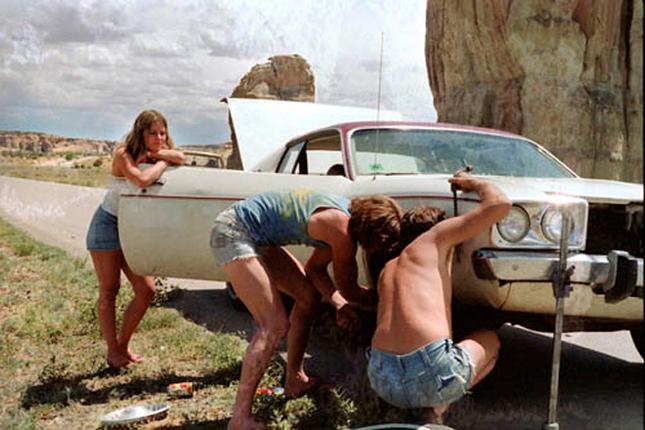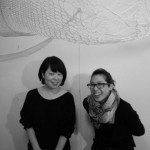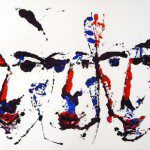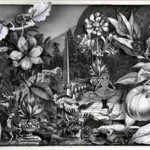City Center Gallery Walk
By • September 21, 2012 0 1583

The American cultural anthropologist Margaret Mead was a keen observer of the riches of modern city life. She spoke of a city as a center “Where any day in any year there may be a fresh encounter with a new talent, a keen mind or a gifted specialist. This is essential to the life of a country.”
“To play this role,” she noted, “a city must have a soul — a university, a great art or music school, a cathedral or a great mosque or temple, a great laboratory or scientific center, as well as … libraries and museums and galleries …”
Scrolling through Mead’s list of highest urban attributes, Washington hits all the marks. We have the schools, the religious and scientific institutions. We are awash in great museums and historic libraries.
By its very nature, the District is a kaleidoscope of history and progression, holding onto our tenets while moving ever into the 21st Century.
And we have galleries. Boy, do we ever. In the heart of this city, encircling Gallery Place and Metro Center amid the glistening glass and steel of arenas, storefronts, apartments and office buildings, art galleries flare against the cultural skyline. Like the Viennese salons of the late 19th Century, there is always someone admiring the artwork worth their weight in conversational gold.
“A city must be a place where groups of women and men are seeking and developing the highest things they know,” said Mead.
In the galleries listed below, the lifeblood of Mead’s persevering philosophy runs strong, proffering the visual arts as a channel to understanding our history, our surroundings and our collective selves.
Plus, they’re just great venues to see some damn cool stuff. ?
Adamson Gallery
1515 14th Street NW, Suite 202,
www.AdamsonGallery.com
“Wild Things,” the summerlong exhibition at Adamson Gallery, is certainly wild, but don’t go in with the expectation of seeing much in the way of the living. This collection of animal photographs showcase the inhabitants of our oceans and wilderness in a not-so-lifelike light (save the charming Weimaraner portraits of William Wegman). Granted, this is not just an arbitrary portrayal of animals post-mortem. For instance, Martin d’Orgeval’s photograph of an owl is an eerie beakless specimen, perched on a dirty pedestal. This image comes from his project to document the aftermath of a 2008 fire in a 170-year-old taxidermy shop in Paris. The artist photographed everything from singed butterflies to charred bears, offering an interesting observation into the nature of what was — or wasn’t — really destroyed in the fire, while showcasing life’s breathtaking diversity. Other notable artists included in the exhibit include Annie Leibovitz, Jim Dine, Roberto Longo and Roni Horn.
Touchstone Gallery
901 New York Avenue NW,
www.TouchstoneGallery.com
Two simultaneous exhibits at Touchstone Gallery show that traditional practices can still thrive in contemporary art. In his exhibit “Being Affected” (through July 29), Charles St. Charles gives us rows of faces with varied reactions to shared circumstances. The show is influenced by work Charles has done in theater and improvisation, where a satisfying portrayal of reality depends on the actor being affected by the other characters and the environment. Charles skillfully uses color, facial expressions and distortions to reflect the status interplays that result in increasingly crammed physical or psychological spaces.
“A 3D Collage the Adventure” is the work of David Alfuth, a longtime art educator who began this series as a class project for his students. The lesson, which used old prints and engraving, “allowed the students to create a surrealistic situation to present to the viewer,” he writes. “The addition of the 3-dimensional qualities allowed for a world of variety and interest.” The works represent a collective narrative journey, dealing with space, architecture and its effects on human experience: relief sculptures with bizarre and funny titles such as, “They landed on the Moon, planted the flag, and then they left. That is when the party got started;” cubist-like constructions of architectural spaces; and simple, powerful line drawings of architectural elements.
Civilian Art Projects
1019 7th Street NW,
www.CivilianArtProjects.com
Civilian Art Projects has enough to keep patrons busy for a while to come, presenting installations by three acclaimed artists working in a variety of media through July 28. Richard Chartier is a sound artist, considered one of the key figures in the current movement of reductionist electronic sound art, termed “microsound,” or Neo-Modernism. Chartier’s minimalist digital work explores the inter-relationships between the spatial nature of sound, silence, focus, perception and the act of listening itself. In his exhibit “Interior Field,” he transforms the center gallery at Civilian Art into a darkened space where a visitor may relax and focus to this sound composition. A significant portion of this piece utilizes several audio recordings made at the 1905 McMillan Sand Filtration Site in Washington, D.C. during a sudden heavy rainstorm.
Bridget Sue Lambert is exhibiting a photographic series of large-scale prints in which she explores and emphasizes the complicated nature of relationships through the humorously messy rooms of a dollhouse, which she has been working with for the last three years. In them, she has constructed and captured scenes that simulate the emotional and physical clutter that surrounds romantic relationships, as well as a woman’s relationship with herself.
Finally, Shamus Ian Fatzinger presents his show ‘Personal Frontier,’ a series of photographs created from negatives found in a cardboard box belonging to his mother that tell the story of the artist’s childhood, and his family’s move West. What emerges is at once a collection of seminal mid-century American snapshots and a lens into our own grainy, beautiful pasts — weird and sexy, vague and pointed, and somehow very familiar.
Flashpoint Gallery
916 G Street NW,
www.CulturalDC.org
From July 20 to August 18, Flashpoint Gallery will exhibit the work of Interdisciplinary artists Hana Kim and Shana Kim, who join forces to work between the disciplines of architecture and interactive media to create an immersive environmental installation. The show, “Atmospheric Front,” combines pulleys, motors, hand-knit textiles and wires that expand and contract in time with sound and light projections. The texture and movement of the multidimensional piece reference biological and natural systems, which evoke breathing cycles, pulse and emotion. For more information on the process behind their work, visit their blog: AtmosphericFront.wordpress.com.
There will be an opening reception Friday, July 20 from 6 to 8 p.m
- Shamus Fatzinger, B | Civilian Art Projects







